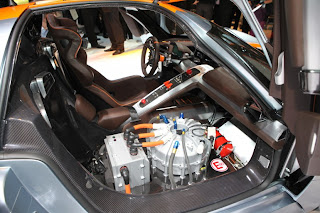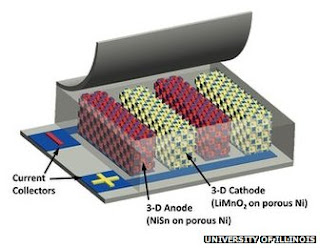 |
| The 1915 Detroit Electric |
During that time sadly virtually no progress was made on a automotive propulsion batteries or electric vehicle motive power. The Electric Vehicle arrived on the scene around the same time as the Internal Combustion power car, and while the EV was supreme in the cities, through accidents of history and industrial conspiracy which you can read about in Edwin Black's "Internal Combustion" the EV passed into the annals of history.
 |
| Electric Citicar - Southward Auto Museum, New Zealand |
Technologists and even motor companies dabbled in electric vehicles during that 100 years, but saw them as toys and quirky golf-cart size "personal transports", like this "Electric Citicar" made between 1972 & 1978 by Sebring-Vanguard. Really these sorts of vehicles were new bodies on the old technologies no better than the lead-acid batteries of the Detroit Electric 60 years previous. They were light-weight experiments instead of real full-blown motor cars. So called electric "neighbourhood cars" still produced today are still evidence of this lack of progress.
Until now.
 |
| The 2013 Porsche 918R Hybrid 770bhp 3s 0-60 (gizmag.com) |
We are also seeing high-performance vehicles powered by electric motors on our race tracks. Vehicles like the incredible Porsche 918 Hybrid. While it does have a petrol power-plant on board as well, the 918 can run on pure battery power, and with advances in batteries (see below) Porsches technology will no doubt be seen in future all electric vehicles. The point is that the electric power train is already seen by high-performance motor engineers as the way forward.
I drive a Nissan Leaf: a practical all electric passenger sedan with a range of 175km and performance equal to or better than similar sized fossil-fuel powered cars. The Leaf has no exhaust pipe and produces zero emissions, so as I drive past schools and sidewalk cafes I can be sure I'm not ruining the air quality for my fellow city dwellers. I don't have to make a regular pilgrimage to buy fuel at gas stations, and any time I go down to the car in my garage its there ready to go, charged up for free courtesy of the solar panels on my roof. Its a clean machine.
But electric vehicle development is not stopping there, and its interesting to wonder how far behind we are after our 100 year sleep, and how quickly we can catch up. Look at the speed of the cellphone revolution for examples of the speed of innovation we can expect.
There are a couple of things to be said about this catchup process - first is that electric cars while already good, they are only going to get better.
Motor-sports aficionados already recognise the applicability of the new technologies in EV and hybrid power, so we are seeing a new age where the petrol-head becomes the electron-head, as speed and handling come from improvements in electronic and electric drive technology.
One example is the active steering and suspension on the Porsche which has many new freedoms for designers of high-performance cars due to the flexibility electric drive gives you. The old CV joint and half-shaft, or conventional differential and driveshaft setup of petrol powered vehicles meant many restrictions on what can be achieved. Porsche engineers are breaking out of these paradigms with the 918 and setting new performance benchmarks as they do so.
 |
| Protean in wheel motor (cleantechnica.com) |
In wheel motors promise huge advances in this area, effectively giving 3 degrees of freedom for suspension geometry design and active (computer controlled electronic) suspension and drive systems. Protean claim also much improved regenerative braking energy recovery. While in-wheel motors have a challenge with unsprung weight that is outweighed many times over by the prospects for fully active suspension, steering and drive that comes from an in wheel motor.
 |
| University of Illinois interdigitated battery architecture (BBC) |
This new battery technology unveiled just days before I write this article comes from the University of Illinois and promises power outputs 10s or 100s of times better than current battery technology.
Update: (thanks Russell!) it was pointed out that the U of Illinois battery is more about power output than watts per size (energy density, or capacity). Other projects are promising big improvements in EV range from higher battery capacity, such as the 3 x lithium-air chemistry and 10 x aluminium-air projects, like the one from Phinergy (although the latter one is currently not rechargeable).
With that sort of energy density my Nissan Leaf would have over 1000km of range on a battery half the size of the one it currently has. Countries that want to improve air quality in their cities while keeping up with the bleeding edge of technology in transportation are investing heavily in the R&D of battery technologies.
Fossil-fuel powered cars will still be around for a long time, but their golden age has past now. No matter how good you make internal combustion engines, they rely on foreign oil and produce pollution. Yes, there are ethanol and other bio-fuels now, but in practice you have to buy E10 or other mixes with petrol. In theory diesels and flex-fuels can use 100% bio-fuels, but its not available now and production in quantity appears to be neither economically viable or environmentally sustainable.
Advances in internal combustion powered vehicles show fewer and fewer returns for R&D dollars spent, compared to electric. There's no flux capacitor or magic catalyst that is going to improve petrol 10s or 100s of times over. ICE cars are about as good as they can ever be and no promised fuel technologies are coming to change that.
I'm driving my 100% emissions free sun-powered electric vehicle today. Right now. No theories, no corn subsidies, all real.
Now the point of all this is that the way ahead for Electric Vehicles is expanding and full of promise. Every new advance brings large improvements in practical areas like range, and carrying capacity. When EV's are powered by clean sources like my solar panels the entire personal transport experience is of low impact to our environment.
How far can the Electric Vehicle go? I'm excited to find out.




